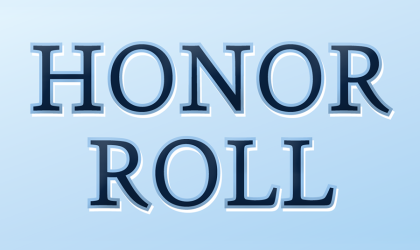

In this blog post, Lower School STEM Teacher Cliff Powers discusses the background and benefits of STEM education.
Defining STEM is a simple task. It is an acronym that stands for Science, Technology, Engineering and Mathematics. But its simplicity ends there. STEM is much more than a catchy buzzword that seeks to combine the four subjects under a single umbrella. At its core, STEM is a teaching philosophy that integrates all four disciplines together into a cross-curricular program that offers instruction in real-world (as opposed to purely academic) applications and teaching methods.
To understand why STEM education has become so popular over the past 20 years, one must first consider the amazing transition between the industrial revolution and the information age.
A Brief History of STEM
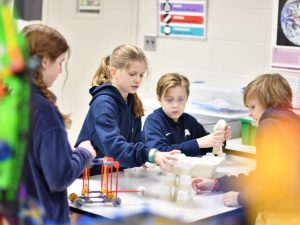
The development of STEM can be traced back to the Morrill Act of 1862, which created land grant universities to promote agricultural science. The Space Race with the Soviet Union not only prompted President Eisenhower to establish the National Aeronautics and Space Administration (NASA) in 1958, but also brought more national attention to science education. More recently, this focus was increased with the birth of home computers, cell phones, and, ultimately, the internet. As a result, the demand for domestic workers proficient in the computer sciences exploded. However, by the end of the 20th century, achievements in the STEM disciplines by students in the United States were falling behind those of other industrialized nations. To address this growing disparity, the National Science Foundation (NSF) created the acronym SMET in 2001 to reflect new standards in science, mathematics, engineering, and technology for K-12 schools. Thankfully, the acronym was changed to STEM later that year. Since that time, numerous governmental initiatives such as No Child Left Behind, Educate to Innovate, and the Inspire Act have called for increased funding and emphasis toward STEM education. Some 20 years later, STEM has now become a common, and in many ways, critical, part of school curricula.
The Four Cs
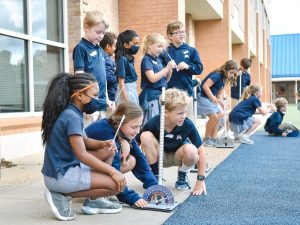
In 2002, the National Education Association (NEA) began a two-year journey to develop what became known as a “Framework for 21st Century Learning.” This project focused on 18 different skills that would equip students for success in a global economy. Over time, it was determined that the framework was too long and complicated. To resolve this issue, four specific skills were deemed to be the most important. They became known as the “Four Cs” — critical thinking, communication, collaboration, and creativity. STEM is a natural extension of these skills, as it embraces each as an essential part of the learning process. In a study reported by The Washington Post, Bloomberg/Businessweek and others, employers said students are unprepared for the workforce. Many claim candidates are applying for jobs without the skills that will make them successful employees. So, what do employers want? In short, they want excellent soft-skills (4Cs) and STEM aptitude. So, let’s take a brief look at each of the “Cs” individually.
Critical Thinking
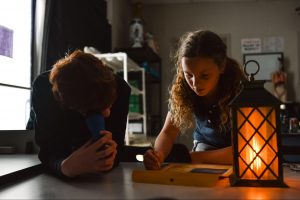
Critical thinking is the analysis of an issue or situation and the facts, data or evidence related to it. It is to be done objectively (without influence from personal feelings, opinions, or biases) based solely on factual information. Under the heading of Critical Thinking are several skill subsets that are an integral part of STEM, including observation, analysis, inference, and problem-solving. One great example of critical thinking usage would be during our Extreme Earth unit that focuses on such lessons as layers of the earth, earthquakes, volcanoes, and tsunamis. During the visit on landslides, groups are given a sloping landscape tray on which they must create retaining walls from clay (problem solving). The goal is to prevent as much erosion as possible to the hillside. Once finished, the tray is backfilled with sand and a saturating “rain” is simulated. Students must observe the results, analyze any weaknesses in their engineering, and make inferences on ways to improve their design.
Communication
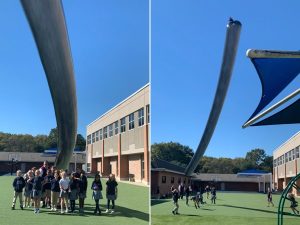
Communication is a necessity in any work industry. Candidates must be able to communicate in many different mediums such as presentations, email, and formal written documents. During STEM projects, not only do the students have to communicate well with one another, they must be able to describe or explain their thought process. The ability to do so in a clear, articulate manner is of paramount importance. During our unit on Air and Water, for example, groups are challenged to create a filtration device from plastic bottles and a variety of materials such as cotton balls, coffee filters, sand, charcoal, etc. Once completed, they test their device by passing dirty water through it. However, the challenge doesn’t end there! We stage this project as an episode of Shark Tank and discuss profit margins and investments. Teams are given a budget and each of the possible filtration materials has a cost assigned to it. This way, the students not only have to think in terms of what will produce the clearest water, but also yield the highest profit margin. Once the testing is complete, each team must use excellent communication skills as they “pitch” their device to Mr. Wonderful (me).
Collaboration
This piece is probably the one that I find most thrilling and mesmerizing to watch. My class is divided into five tables, each of which ideally accommodates four students; although, due to varying class sizes, some tables have only three students. These are mixed by gender so that most tables group together two boys and two girls. While there are times that each child is working on his/her own individual project, groups are usually working together collaboratively to complete the project at hand. As they strive to find a harmonious balance between the more assertive personalities and more timid ones, they learn to appreciate and value differing approaches and solutions. I have had many Lower School teachers tell me that they have seen an improvement in how well their students work together in the classroom as a result of Stem Lab. Learning to work well with others is a life skill that will pay dividends long after graduation.
Creativity
In STEM, creativity is probably best defined as “thinking outside of the box.” While there are times that it manifests itself in more artistic or aesthetic ways, designing a unique structure, vehicle, or gadget certainly involves a great deal of creativity. There are times when the students are constructing from instructions, because I believe the ability to interpret a set of plans or sequenced steps is also a valuable skill. But my favorite “builds” are the ones where the children must rely on their own imaginations to complete a project from inception to execution. One of the favorite regular visits by my third and fourth graders is called “Girls vs. Boys Day.” These are held at the end of most six-visit units and based on the subject matter we just completed. Each of the two groups is given an oversized building set of various sticks and connectors (think giant Tinker Toys) and given a project to build. For example, at the end of their Marine Biology unit, fourth grade teams were charged with building a submarine that could contain their entire team. Points are given based on teamwork, detail, realism, etc. I absolutely love seeing them work together to create something strictly from their collective imaginations. These lessons are a perfect example of integrating all four of the Cs into a single project.
Adding the Secret Sauce
In addition to integrating the Four Cs, I also incorporate two philosophies that have guided me through my entire 29-year teaching career. The first is that, regardless of subject matter or age, learning should be FUN. Every single STEM visit during the four-year journey began with a desire that it be fun and engaging. In fact, most activities that get replaced are because I found something that I thought would be more fun for my students! A perfect example of this just materialized over the past few weeks. I got the idea to stage three different elaborate Escape Rooms for my fourth-grade students. These are themed to an Egyptian Tomb, Blackbeard’s Treasure, and Harry Potter. Designed to take two visits each to complete, each of the fourth-grade classes is rotating through the different rooms over a three-week period. While my educational objectives include critical thinking, problem solving, collaboration, code decryption, and data collection, the kids simply find themselves immersed in a dimly lit place of fog, flickering lanterns, thematic music, strange props, hidden clues, and the freedom to explore with flashlights to locate and solve the eight challenges. The level of excitement shown is just unbelievable and so gratifying to see firsthand. My hope is that they never lose this love for learning as they grow older.
The second philosophy that guides everything we do in STEM is approaching science from a biblical worldview. I consider teaching to be a spiritual gift, and, as such, I want our Father’s name glorified in everything we study. I can think of no other subject that speaks to the awesome handiwork of God like science. Whether that be the intricacies of the human body, the endless boundaries of space, the physical laws of the universe or the miracle of life itself, we acknowledge God to be the creator, author, and sustainer of it all.
In Conclusion
I hope you have enjoyed this insight into STEM Education and, specifically, our Lower School STEM program. Being a STEM instructor and working for Jackson Academy has been the highlight of my teaching career. I have been so blessed to work with such amazing professionals and leaders in the Lower School department. Next year, the program and I will be celebrating our tenth anniversary at JA! I can’t wait to see what the future holds. One thing is for sure; I know the kids will have an absolute blast as they prepare to tackle our 21st century world.
